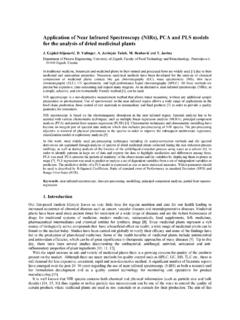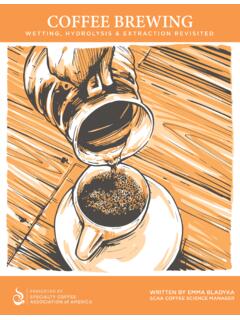Transcription of Cleaning and inspection of EUV reticles: specifications ...
1 Cleaning and inspection of EUV reticles: specifications and prospects Luigi Scaccabarozzi1, Niels A. Lammers2, Roel Moors1, Vadim Banine1. 1. ASML Netherlands , De Run 6501, 5504DR, Veldhoven, The Netherlands 2. Technical University Eindhoven, Eindhoven, The Netherlands Corresponding author: Luigi Scaccabarozzi ASML Netherlands , De Run 6501, room 4F1004. 5504DR Veldhoven The Netherlands Tel: +31 40 268 8054. Email: 1. Abstract: Due to large absorption of EUV light, EUV reticles are not expected to have pellicles for particulate contamination protection. The lack of a pellicle means that having a means of Cleaning and inspecting pellicles that could be adapted to in-situ use is of great interest. Even nanosize particles could result in fatal defects in every die of the wafer. Consequently, measures must be taken to detect and remove any particle above a certain critical size, accidentally deposited on the reticle .
2 Here we present the issues and challenges we are facing in the detection and removal of particles from EUV reticles. Very stringent specifications are required to ensure that practically no particle is present at the time of exposure. We will then give an overview of the technologies that ASML is investigating in order to meet these specifications . These include laser scatterometry techniques for the inspection part and different dry Cleaning techniques. For the former, the challenge is the detection of sub 50nm particles on patterned reticles within minutes, while for the latter, the main challenge is to remove any type of particle (organic/inorganic) in the same timescale and without damaging the pattern. Results, including Cleaning of 50-nm PSL spheres using dry techniques, will be discussed. Key words: EUV reticle , EUV mask, mask Cleaning , mask inspection 2. I. Introduction The IC market growth is driven by both the exponential shrinkage of the component size on the chip and the exponential cost reduction per component.
3 The key technology to enable this shrinkage is optical lithography. The current mainstream technology is based on the 193nm (wavelength) immersion technology, employed to print features with a lateral critical dimension (CD) of 45nm (which corresponds to half pitch, hp, in dense lines). This technology can be extended to the 32nm node (CD=32nm) with a significant increase in complexity involving, , double-patterning technology [ref1]. Beyond the 32 nm node a major change in technology is required and the most dominant candidate is Extreme Ultraviolet lithography (EUVL). This technology is based on wavelength. This dramatic decrease in wavelength will bring a straightforward gain in resolution, but several issues have to be addressed for the commercial success of EUVL. These include the generation of radiation at the EUV wavelength (100W of in-band radiation at intermediate focus will be required) and the difficulties due to the high- absorption of this radiation by virtually all materials, including gases (of the order of percent per nanometer of thickness for solid materials).
4 Because of this, the optical path must be in vacuum and all optics must be reflective ( , mirrors instead of lenses), including the reticle . Contamination also becomes a critical issue, especially for reticles. In fact, contrary to DUV reticles (used for 193nm), because of high material absorption EUV reticles do not have a protective pellicle in proximity of the surface to prevent particles to accidentally fall on the patterned area, especially during handling and exposure. Because of the pellicle DUV reticle contamination is important only at particle sizes relatively large (>~5 m), since smaller particles on the pellicle are not imaged 3. during exposure and do not result in a defect. However, in the EUV case, the particle is in direct contact with the pattern, thus the critical particle size is comparable with the CD. (as illustrated in the next Section). A single particle on the reticle may result in a fatal defect in every die of the wafer (batch), corresponding to zero-yield.
5 For this reason, contamination of the reticle during all phases of its lifetime must be addressed. An industry-wide collaboration resulted in the Dual-Pod carrier system, which was demonstrated to be very effective in preventing particle contamination during handling of the reticle [2]. The Dual-Pod consists in two boxes , one inside the other. This double protection system proved that contamination of less than particles/ reticle over the entire lifetime is possible (where lifetime is defined as round-trip shipment, vacuum pump/vent and storage, inspected at 53nm minimum size). The other critical phase of the reticle lifetime is inside the lithography tool, during exposure. Although the reticle will be in an ultra-clean vacuum environment, because during exposure it cannot be protected with the Dual-Pod, there is still a small risk of particle contamination. Exposed wafers will have to be checked for defects off-line and, if necessary, the reticle will have to be removed from the machine and cleaned.
6 Although no Cleaning technique currently exists that meets the requirements for EUV reticles, there is significant effort worldwide in this direction. For example, Sematech, in collaboration with Hamatech Gmbh, achieved Cleaning of >10nm particles from reticle blanks (=without pattern) using a combination of wet/dry techniques [3]. Although inspection and Cleaning can be done off-line, ASML is investigating techniques that can be employed to inspect and clean the reticle inside the lithography tool. Integrating such functionalities in the machine should decrease the risk of fatal defects 4. due to particles on the reticle and should increase the throughput. The main issues of reticle Cleaning / inspection will be illustrated in Section II, while the requirements that these techniques must satisfy will be detailed in Section III. These techniques have to be compatible with vacuum environment, which means that only dry techniques can be employed.
7 In Section IV we will review some of the Cleaning techniques investigated and their current status. In Section V we will discuss the more challenging problem of inspection . II. Overview of Cleaning / inspection issues A EUV reticle consists in a 6 x6 x1/4 quartz or low-thermal-expansion material substrate with a reflective multilayer (ML) coating and an absorber pattern on top, as shown in Figure 1. The coating consists of ~40, Mo/Si, /4 pairs of about 200nm total thickness. A capping layer (like Ru or Si) is often used. The pattern is defined into an absorbing layer ( , TaN/TaNO). The size is 4 times larger than the CD (because of 4x demagnification factor between wafer and reticle ) and the thickness is about ~70nm. The pattern is in principle arbitrary and can be composed of (dense) lines, contact holes, periodic and non-periodic patterns. Because the lithography tool is extremely complicated and utilizes many different materials, we can in principle have any type of particle deposited on the reticle ( , organic, inorganic, metallic, such as Al, Fe, Al2O3, ceramics, etc.)
8 And thus we must be able to remove any type of particle. The particles could be conductive or insulating, they can be of any shape and any size and could be deposited on the (conductive) coating or on the (insulating) absorber. 5. A first challenge in reticle Cleaning consists in removing the particles without damaging the substrate. Damage either to the ML or to the pattern has to be absolutely avoided (see Section III). Because the reticle is composed by different materials and has a complex structure, it is very fragile. For example mechanical stress could peel off the coating from the substrate or heat could cause interdiffusion of the Mo/Si layers, reducing the reflectivity. A second challenge lies in the presence of the pattern: particles can in fact get trapped in trenches or holes, which would make the removal by physical means (fluids, shockwave) very difficult to apply. The pattern constitutes also the main challenge in reticle inspection .
9 Typically, laser scatterometry or dark field techniques are used to inspect bare surfaces, exploiting the fact that particles scatter light isotropically, whereas a flat surface specularly reflect light. These techniques, however, are not applicable to structured surfaces, because of the strong scattering of the pattern itself (see Section V). The main challenge in reticle inspection is then the ability to distinguish a particle from the background pattern within the required amount of time and with the required sensitivity (see next Section). III. Cleaning and inspection specifications A certain number of specifications (listed in Table 1) have to be met for a Cleaning /. inspection technique to be integrated in the lithography tool. The minimum particle size to remove/inspect is defined by the following equation: 1. Size = CD Mag / MEF , (1). 2. where Mag is the demagnification factor between reticle and wafer (=4) and MEF is the mask error factor, which depends on the exposure parameters and is usually calculated 6.
10 Numerically. In our case the MEF varies between and and, because of this, the particle size decreases more than linearly with respect to the CD. As mentioned earlier, in principle the inspection / Cleaning technique should be able to handle all types of particles. The maximum number of cleanings in a reticle lifetime has been estimated as ~300, which is the estimated limiting case of intensive reticle usage over 6 months. The actual number of cleanings will vary largely in function of the specific reticle , process and customer and will be in the range ~20-300. The two main requirements for Cleaning are Particle Cleaning Efficiency (PRE) at minimum particle size and damage to the reticle . The required PRE insures that every particle will be removed during the entire lifetime of the reticle . We assume that at the time of Cleaning only a few particles (ideally only 1) will be present on the reticle . These requirements translate in a PRE of for the limiting case of 300 cleanings and of 95% for the best case of 20 cleanings.







